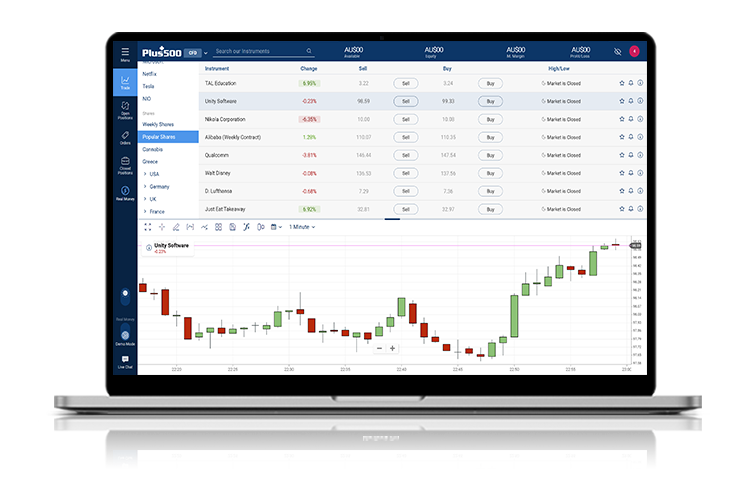Stock Sectors
From tech, energy and materials, to healthcare, financials and real estate, the stock market is a multifaceted and multidimensional sphere that covers multiple sectors. These different sectors have the ability to affect the overall market.
In order to start trading stocks CFDs, it helps to know and understand the sectors of the economy into which the stock market is divided. These sectors provide structure to the market and are important to take into account, since industries often move together. This will give you a deeper understanding of what moves groups of stocks and accordingly, when their prices are likely to fluctuate. Below are explanations of each of the sectors:

Illustrative prices.
Technology
Technology companies tend to focus on software, hardware, artificial intelligence (AI), information technology (IT), or process-related technologies. Investment in tech stocks has gotten more popular over the past two decades especially with the emergence of new technologies like the metaverse as big tech companies like NVIDIA, Meta, and Microsoft adopt this burgeoning technology. Some of the most popular companies in this sector are Meta, Apple, Microsoft, Sony, Alibaba and Alphabet. It is important to keep in mind that, since the technology sector tends to be made up of fast growing companies, tech stocks can be extremely volatile.
Financial
Financial stocks encompass a wide variety of companies, such as banks, insurance brokers, payment processing companies, mortgage lenders, and others. Some popular companies in this sector are Visa, Morgan Stanley, Wells Fargo & Co, Goldman Sachs and PayPal. Financial companies are tied to the economy, so they provide a way to trade general market trends. Due to their stabilizing mechanisms and close regulation, financial stocks tend to be less active; however, they are generally considered solid companies and good long-term investments.
Energy
By trading stocks in the energy sector, you are able to buy or sell shares in companies that, for example, extract or produce important commodities such as crude oil, natural gas and electricity. In fact, the bulk of the energy sector is dominated by big oil companies, such as Chevron, BP and Exxon Mobil. In general, the performance of the energy sector stocks is closely related to the price of crude oil. The energy sector is relatively stable, however at times can experience extreme volatility due to its sensitivity to geo-political events.
Industrial
Industrial stocks are considered to be one of the oldest sectors worldwide. In fact, one of the oldest stock indices, still in-use today, is the Dow Jones Industrial Average. Moreover, the industrial sector is made up of construction, defence, machinery, healthcare, and aerospace corporations, as well as airlines, among others. Some popular companies in this sector are 3M, FedEx, Boeing, American Airlines and CVS Health Corp. The value of these companies tends to move along with military /defence operations and the overall economy.
Consumer Discretionary
These are companies where consumers spend their extra income. The consumer discretionary sector encompasses retailers, apparel companies, restaurants and service providers. Some popular companies in this sector are McDonald’s, Nike, Gap and General Motors. Stocks belonging to this sector tend to thrive in growing economies and can benefit from the power of their brand recognition. If, for example, traders love a certain brand, they may choose to invest in it, making the company’s shares “affinity stocks.” Nevertheless, traders should be aware of the fact that this sector can be affected by factors like inflation, price changes, and supply chain issues.
Consumer Staples
The consumer staples sector consists of companies that make basic products such as food and beverages, personal products and household goods. These products are considered essential by consumers, who buy them on a regular basis. Some of the popular companies in this sector are Procter & Gamble, Coca-Cola, Colgate-Palmolive and Walmart. This sector tends to be relatively stable since it comprises the companies that people will continue to buy from, even in times of crisis.
Utilities
This sector is comprised of companies that provide utilities such as water, electricity, and gas. They tend to operate locally with little to no competition. Since people need these services on a consistent basis, the utilities sector tends to be considered a defensive stock sector. For example, during the first quarter of 2020, traders opted for technology, financial, and energy sectors as the demand for global electricity fell by 2.5%. Companies belonging to this sector include CMS Energy Corp and Sunrun Inc.
Communications
Consists of phone companies, internet providers and satellite and wireless companies, among others. Examples of companies in this sector are Netflix, Disney, Telefonica and Vodafone. Most of these companies rely on recurring revenue, so they have a predictable income and are less volatile. However, there are many factors that could shake this sector’s stability. For example, antitrust investigations and the semiconductor chip shortage crisis, which could carry-on to 2023, could lead to a fall in this sector’s stocks.
Healthcare
The Healthcare sector is made of hospitals and other healthcare providers, medical devices, and healthcare equipment companies and pharmaceuticals and biotechnology companies. Furthermore, it is the second-largest industry in the S&P500 index ,they represent over 10% of the Nasdaq Composite Index, and 5 out of 30 companies in the Dow Jones Industrial Average index are in the healthcare sector. People always need medical care, either in the form of doctor or hospital visits, or as pharmaceutical drugs and medical equipment. Therefore, this sector is considered stable. Some popular stocks in this sector are Abbott, Medtronic, Johnson & Jonson, CVS Health and United Health Group Inc. Other companies that gained more recognition due to the COVID-19 pandemic are Pfizer and Moderna.
Basic Materials
Companies in this sector provide to other companies the supplies they need to make their products. These companies discover, develop and process raw materials such as oil, lumber, glass, or gold. The basic materials are then used by manufacturers, construction companies, chemicals and other companies to make final products for the general population. This sector is closely related to business cycles and tends to flourish with strong economies, but that also means that this sector can be challenged by rising competition in the market and might suffer during bearish market trends. Some popular stocks in this sector are Chevron, Vulcan Materials and Rio Tinto.
Real Estate
This sector consists of real estate investment trusts, real estate developers, brokers, realtors, financiers, or any company connected to the real estate market (residential, retail or industrial). These are the companies in charge of building, operating and buying/selling real estate. Some popular companies in this sector include Re/Max, Simon Property Group and British Land. This sector reacts to interest rate changes, as well as the general appreciation or depreciation of real estate. These stocks are generally considered investors’ top-picks because of their strength. However, in the midst of the coronavirus crisis, this sector faced multiple losses especially in the third quarter of 2020, when this sector fell by 57% in comparison to the period in 2019. Traders can also get access to multiple leading real estate companies by tracking them through Plus500’s Real Estate Giant’s Index.

Illustrative prices.
Trading Stock Sectors
Generally speaking, you should only invest in stocks issued by companies that operate in a sector you understand, or stocks that you are familiar with. Knowing the stock sectors and what they react to can be a good starting point to get to know the market and choose what to trade. After choosing a sector, you can choose the stocks you want to trade and research them in order to further your understanding.
Trading platforms such as the Plus500 platform exposes traders to a variety of stocks from all sectors through Contracts for Difference, or CFDs.
Final Thoughts
Knowing and understanding stock sectors can be a key factor to choose what stocks to trade. Each sector is moved by different factors and in different ways. Each sector has a different risk level, volatility, trading volume, and stability. Thus, sectors move up and down at different times and rates. You should analyse which sectors align with your personal trading preferences and goals. Then, you should conduct your own, more extensive research before choosing to trade a particular company’s stock.
Check out the different categories of stocks offered for trading as CFDs on the Plus500 trading platform.
